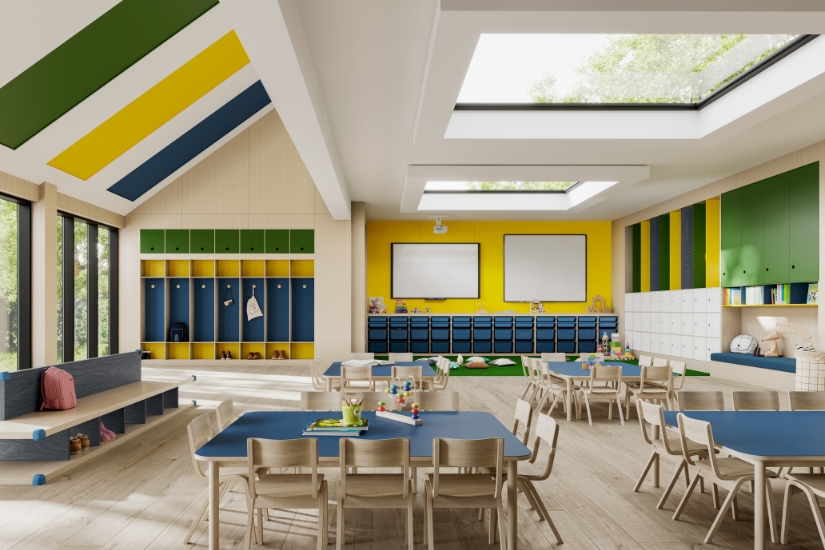Designing Neuro-Inclusive Learning Spaces: From Nursery to University
From Nursery to University: Top Tips for Designing Neuro-Inclusive Learning Spaces
As the principles of neuro-inclusive design extend to various sectors, education environments hold particular significance. From pre-school settings to universities, thoughtfully designed spaces can support the diverse needs of students and help them reach their full potential.

By considering colour, texture, lighting, and flexibility, designers can create learning environments that foster comfort, concentration, and curiosity.
Early Learning Spaces: Setting the Foundation
In early childhood education, the physical environment plays a crucial role in shaping a child’s personality, self-esteem, and capacity for learning. Drawing on the insights of educators like Dr. Maria Montessori, it’s clear that the right combination of tones, textures, and lighting can make a significant difference.
- Colours and Light: Light, pastel tones create a calm and reassuring atmosphere, while softer hues help minimise visual overstimulation. Bright, warm colours can still be introduced thoughtfully, providing gentle stimulation without causing sensory overload. For instance, a palette that includes pale greens, muted pinks, or soft blues can enliven a space without overwhelming young learners.
- Tactile Elements: At this age, children rely heavily on touch to explore their surroundings. Textures and temperatures provide valuable sensory information, enriching their developmental experiences. Incorporating accessible textures—through tactile surfaces, natural materials, —encourages children to interact with their environment, building motor skills and confidence.
By thoughtfully balancing soothing colours, varied textures, and inviting layouts, early learning settings can provide the security and comfort that children need to thrive during these formative years.

Ernestine Nursery | Photo by Tim Van De Velde
Flexible, Student-Centred Spaces in Higher Education
As learners progress to university environments, their needs become more varied, and the spaces they inhabit must adapt accordingly. Creating flexible learning areas allows students—neurodivergent or otherwise—to find the conditions that best support their focus, creativity, and well-being.
- Modular Furniture & Adjustable Layouts: Movable desks, sliding wall panels, and standing tables encourage learners to personalise their environment. Whether students prefer traditional seating, casual group sofas, or quiet corners for independent work, flexibility ensures that everyone can engage comfortably.
- Retreat Spaces for Recharging: Not all learners can maintain focus in bustling, energetic classrooms. Retreat areas with dimmed lighting, comfortable seating, and nature-inspired elements provide students with a calm sanctuary when they need a break.
By combining adaptive furniture, varying types of workspaces, and quiet havens, universities can help reduce anxiety, support concentration, and promote inclusive participation in all aspects of campus life.

Harmonious Colour Palettes and Tactile Elements
As in the office sector, colour selection and material choice in education settings can subtly influence mood, energy, and engagement. The muted tones in a palette created Nina Bailey, Formica Group’s European Design Lead, allow for gentle visual interest without overwhelming learners. Complementary reds and greens offer a harmonious feel, while neutral backdrops maintain a soothing baseline.
Central to this palette is F8910 Raw Birchply, providing a natural, calming foundation that highlights subtle grains and warmth. From there, a selection of soft tones can be introduced:
- F8141 Adobe, F8238 Blush, F8858 Just Rose: These gentle, warm shades add a touch of visual comfort.
- F7853 Ocean Grey, F8245 Marble Green, F5936 Lulworth Flint: These cooler tones offer tranquillity and sophistication, helping to maintain focus.
The delicate balance of warm and cool hues, combined with a mix of solids and woodgrains, creates a welcoming environment. Carefully chosen finishes allow for a subtle interplay of colour, pattern, and texture that keeps learners engaged without feeling overstimulated.

A Path Towards Inclusive Learning
Neuro-inclusive education environments acknowledge that every learner is unique. By combining gentle colours, tactile textures, flexible furnishings, and quiet retreat areas, educators can ensure that pupils—from pre-school to university—feel supported, engaged, and understood.
Whether it’s the nurturing softness of a pre-school nursery or the adaptable, multifaceted layout of a university campus, neuro-inclusive design strategies help create spaces that respect individual differences and empower learners to thrive on their own terms. As we embrace these design principles, we move closer to a future where every educational setting is a place of comfort and exploration.



